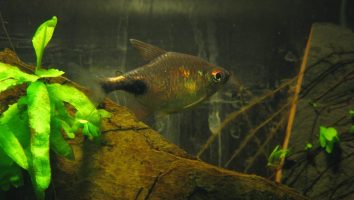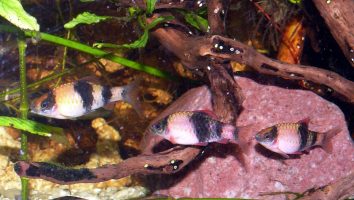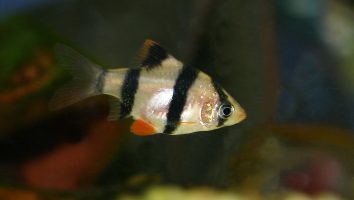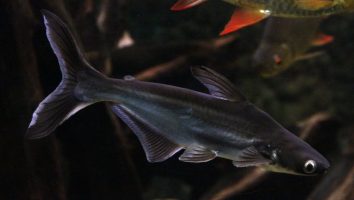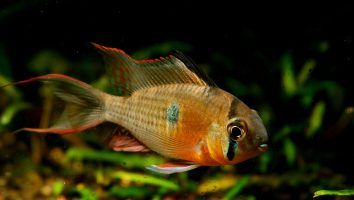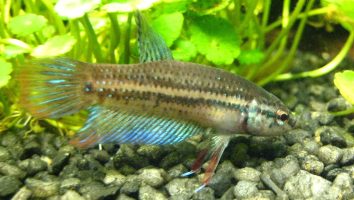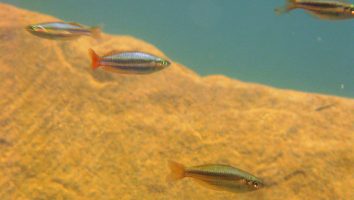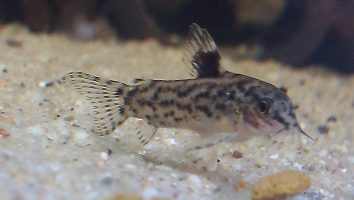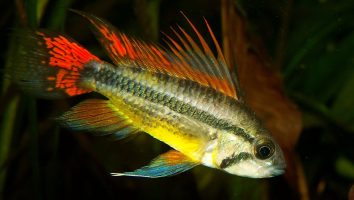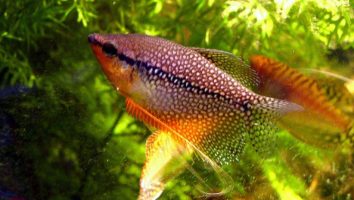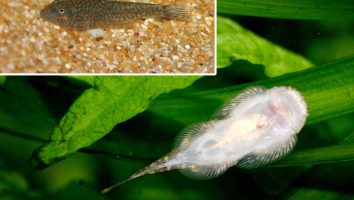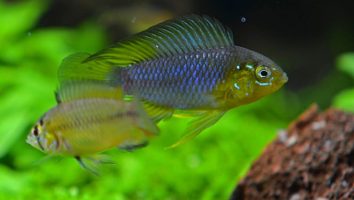The Pickerel is a freshwater fish that is closely related to the pike. They are a long and slender fish with a torpedo-shaped body. Pickerel are known for their voracious appetite and their ability to grow quickly.
Pickerel are a popular choice for aquariums because of their unique appearance and their relatively easy care. In this guide, we will go over everything you need to know about Pickerel care, diet, and tank mates.
Table of contents
Species overview
Pickerels are a type of freshwater fish that belongs to the pike family. There are three main species of pickerel fish: the chain pickerel, the redfin pickerel, and the grass pickerel.
Pickerels are typically found in North America, specifically in the eastern United States and Canada. They prefer slow-moving waters and can often be found in ponds, lakes, and streams.
Pickerels are carnivorous fish and their diet consists mostly of smaller fish, insects, and crustaceans.
Pickerels are a popular choice for sport fishing due to their fighting ability and their tasty flesh. They are also a popular choice for aquariums, although they can be quite aggressive toward other fish.
Appearance

The Pickerel is a freshwater fish that’s easily distinguished by its long and slim body. These fish can grow quite large (up to 24 inches in some cases) but are typically around 12 inches when fully grown.
The body of the Pickerel is dark green in color with a brown or black mottled pattern. The belly of the fish is a lighter white or cream color.
You’ll also notice that the Pickerel has a rather long and pointed head. The mouth of this fish is filled with sharp teeth that they use to snag their prey.
The dorsal fin of the Pickerel is rather tall and starts about two-thirds of the way back on the body. The anal fin is a bit shorter and also starts around two-thirds of the way back.
Both of these fins have a dark color with a light edge. The caudal fin is forked and symmetrical.
The Pickerel is a fast-moving fish that’s known for being quite aggressive. They’re not the best fish to keep in a community tank unless you have a very large tank and your other fish can outswim them.
Lifespan
The average lifespan of a Pickerel is around 6 to 8 years. However, there are a number of factors that can impact this.
For starters, Pickerel that are wild caught generally don’t live as long as those that are born in captivity. This is because they’re not used to the water conditions and diet that they’ll encounter in most home aquariums.
Additionally, Pickerel are relatively delicate when they’re young. It’s not uncommon for them to die within the first year of life if they’re not properly cared for.
As these fish get older, they become more resilient and their lifespan increases. With proper care, it’s not uncommon for Pickerel to live for 10 years or more.
Size
The average size of a Pickerel is between 18 and 20 inches long. However, they can grow to be up to 30 inches long!
Tank
Tank Size
The recommended tank size for a pickerel is 30 gallons. If you’re planning on keeping more than one fish, you should add an additional 10 gallons for each fish.
Pickerel are a predatory fish and can be aggressive, so it’s important to give them enough space to hide and feel safe. Hiding places can be created with rocks, plants, and other decorations.
Water Parameters
The best way to ensure a healthy environment for your pickerel is to recreate its natural habitat as closely as possible. That includes the water parameters.
Here are a few things to keep in mind.
First, pickerel prefer cool water. They’re a freshwater species, but they do best in water that’s on the cooler side. That’s why you often see them in ponds and lakes with a lot of vegetation.
Second, they like their water slightly acidic. The ideal pH range is 6.5 to 7.5.
Third, pickerel need plenty of dissolved oxygen in the water. A good rule of thumb is at least 4 ppm.
Finally, water hardness isn’t as critical, but they prefer soft to moderately hard water.
- Water Temperature: 50°F to 70°F
- pH Levels: 6.5 to 7.5
- Water Hardness: Soft to moderately hard
- Alkalinity Levels: Not as critical
What To Put In Their Tank
Pickerel are a freshwater fish that are often found in ponds and lakes. In the wild, they typically inhabit areas with a lot of vegetation.
When it comes to setting up their tank, you’ll want to recreate this environment as best as you can.
The substrate should be a dark color to help camouflage the Pickerel. You can use gravel or sand, but make sure it’s not too light in color.
Plants are a must in a Pickerel tank. They provide cover for the fish and help to filter the water. We recommend using a mix of live and fake plants. Live plants are nice because they help to oxygenate the water, but they can be a pain to take care of.
Fake plants are low maintenance and can be just as effective. Just make sure to get ones that are made of a soft material (silk or plastic).
Rocks, driftwood, and caves are all great additions to a Pickerel tank. They provide hiding spots for the fish and help to make the tank look more natural.
Avoid using anything that’s too small. Pickerel are known to eat smaller fish, so you don’t want to give them any potential snacks.
Common Diseases
The Pickerel is a hardy fish that doesn’t often fall ill. However, there are still a few diseases that you should be aware of.
The most common disease that these fish experience is called “Hexamita”. This is a parasitic infection that can cause a variety of symptoms, the most common being weight loss and a loss of appetite.
Other potential symptoms include:
– lethargy
– listlessness
– cloudy eyes
– white spots on the skin
If you notice any of these symptoms in your Pickerel, it’s important to take them to the vet as soon as possible. If left untreated, Hexamita can be fatal.
Another disease to be aware of is “Dropsy”. This is a condition that causes the fish’s body to swell up with fluid. It’s often the result of poor water quality and can be fatal if left untreated.
If you notice your Pickerel starting to swell up, it’s important to take them to the vet immediately.
The best way to prevent these diseases is to maintain the quality of the water in their tank. A tank with clean and stable water conditions always leads to healthier fish who are more resistant to disease.
Behavior & Temperament
The Pickerel is a freshwater fish that is native to North America. It is a member of the pike family and is closely related to the Muskellunge.
The Pickerel is a predatory fish and is known for being a voracious eater. It is an aggressive fish and is not afraid to take on fish that are much larger than itself.
The Pickerel is an opportunistic feeder and will eat just about anything that it can fit into its mouth. It is not a picky eater and will even eat other Pickerels if given the opportunity.
The Pickerel is a solitary fish and is not known to school with other fish. It is a territorial fish and will often defend its territory from other fish.
The Pickerel is a fast swimmer and is known for its quick and sudden movements. It is an agile fish and is able to maneuver itself in and out of tight spaces.
The Pickerel is a popular game fish and is sought after by many anglers. It is known for putting up a fight when hooked and is considered to be a good fighter.
Tank Mates
When it comes to finding the right tank mates for a Pickerel, the options are unfortunately quite limited.
This is because these fish are rather territorial and can be quite aggressive. They’re not the best community fish and are better off being kept alone or with a very select few tank mates.
That being said, there are a few species that can hold their own against a Pickerel. These fish are typically large, fast, and aggressive themselves.
Some possible tank mates for a Pickerel include:
- Muskellunge
- Northern Pike
- Lamprey
- American Eel
- Huchen
- Wels Catfish
- Arowana
- Payara
Breeding
Pickerels are easy to breed in captivity. All you need is a large tank and a few other fish to help with the process.
To start, set up a tank that’s at least 50 gallons. Then, add some plants and hiding places. These fish like to have a lot of cover.
When ready, add 2-3 females for every male. The males will be the larger fish.
You don’t need to make any changes to the water. Just keep it clean and well-filtered.
Feed the fish a high-quality diet. Then, wait for spawning to occur.
Females will lay their eggs in the plants. After they’re fertilized, the males will guard them.
The eggs will hatch in about a week. When they do, remove the adults and begin feeding the fry baby brine shrimp.
Conclusion
The Pickerel is a great fish for beginner and experienced fishkeepers alike. They’re easy to care for and don’t require a lot of work to keep them healthy and happy.
They’re also a great addition to any community tank, as they get along well with other fish.
If you’re looking for a low-maintenance fish that will add some color and personality to your tank, the Pickerel is a great choice!

